Sunday, February 19, will mark 78 years since the wake of hundreds of landing crafts foamed the sea off a place most Americans had never heard of. It was a small island called Iwo Jima, and it was taken by the U.S. Marines in the bloodiest battle of the Pacific in World War Two. Before it was over, 7,000 Marines had been killed and 20,000 wounded, along with 22,000 Japanese defenders, almost all dead.

This painting by the late Fort Lauderdale artist Bob Jenny set off a remarkable chain of events.
Those American casualties were largely Marines, but other services took some losses as well. One of them was a Navy pilot, flying perhaps the only Navy plane to go down the day of the invasion. He was Lt. JG Thomas McCormick, my cousin. There was a certain mystery about his death, one that was not explained until six decades had passed. We will get to that.
Tommy was a special man. His father, a year younger than my dad, had married young, my father not until 37. Thus the 15 years between us. I was eight years old the Christmas of 1944 when he came home on leave, less than two months before he died. I remember him as if it were yesterday, sitting around our breakfast table in his Navy blue uniform, a big, athletic and strikingly good-looking guy who was held in affection by all his relatives. He had grown up between Atlantic City and Philadelphia – his father was an alcoholic and separated from his mother. He had been a high school football star and played for what is now La Salle University, on the last team the school had before it dropped the sport in 1942 because so many of its students had left for the war.
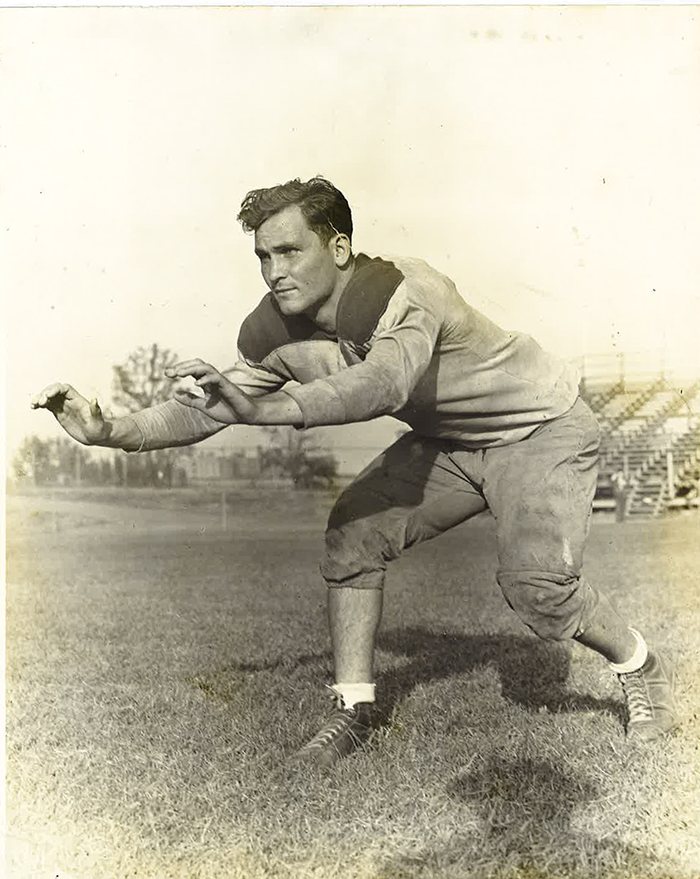
Tommy McCormick in his practice uniform at La Salle University in 1942.
Tommy flew a Chance Vought Kingfisher, the Navy’s float plane used for aerial observation and water rescues. It was catapulted from large ships, in his case the battleship USS Tennessee. He was lost during the Iwo Jima invasion, and for years that’s about all the family knew. The standard telegram to his mother in Atlantic City said he was missing in action, and the family waited a year hoping that, like a number of Navy pilots, he might show up on some remote island. In fact, he was never missing. Hundreds of men on ships saw his plane go down, and the Tennessee listed him as killed in its monthly report. It was also strange that Tommy’s mother never got a visit from a Navy representative, the usual protocol in such circumstances.
The mystery deepened decades later when my brother Frank, a Navy officer in Admiral Rickover’s nuclear program, decided to check the log of the Tennessee on that fateful morning. It revealed that Tommy’s plane broke apart without an explosion or signs of battle damage. Its tail assembly missing, it plunged quickly into the sea. Tommy and his observer never had a chance to bail out.
That struck us as strange, for the Kingfisher was a sturdy machine, capable of taking the stress of catapult launchings and rough water landings. The explanation came through a remarkable coincidence. The late Fort Lauderdale artist Bob Jenny, who loved painting aircraft, did a painting of a Kingfisher over the Tennessee the day of the invasion. It hangs in my office. When I learned about the USS Tennessee Museum in Huntsville, Tennessee, I sent a copy, thinking it might interest them. The response was startling. The museum founder and curator, Paul Dawson, knew exactly who Tommy was. He even had photos we never knew existed, including one of Tommy flying his plane. It turned out his father had been the ship’s photographer and knew the handful of pilots aboard. He even flew with them to take aerial shots. He identified Tommy in photos he saved for decades.
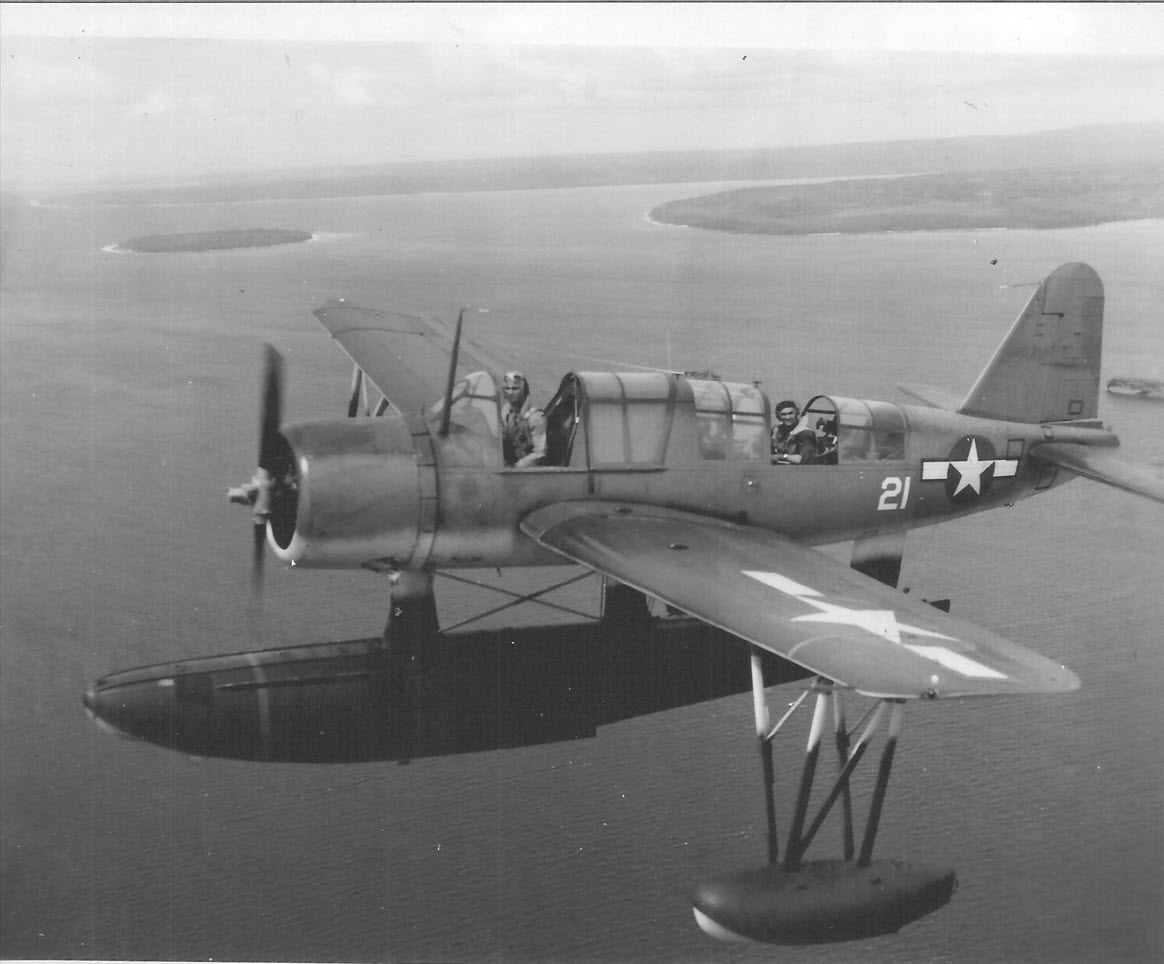
USS Tennessee Museum curator Paul Dawson found this photo, never seen by the family, of Tommy McCormick piloting his plane.
Dawson took over from there. He searched the ship’s records and found that Tommy had crashed a plane in a rough water landing on his first tour to the Philippines in late 1944. Then came the bombshell. He discovered a confidential Iwo Jima “after battle” report that said that a projective had been seen to hit Tommy’s plane and knock the rear completely off. And in its concluding paragraphs, it said that it was possible that an errant shell fired from a long-range Navy gun may have been that projectile. It recommended that steps be taken to assure spotter stayed above the trajectory of the guns they were directing.
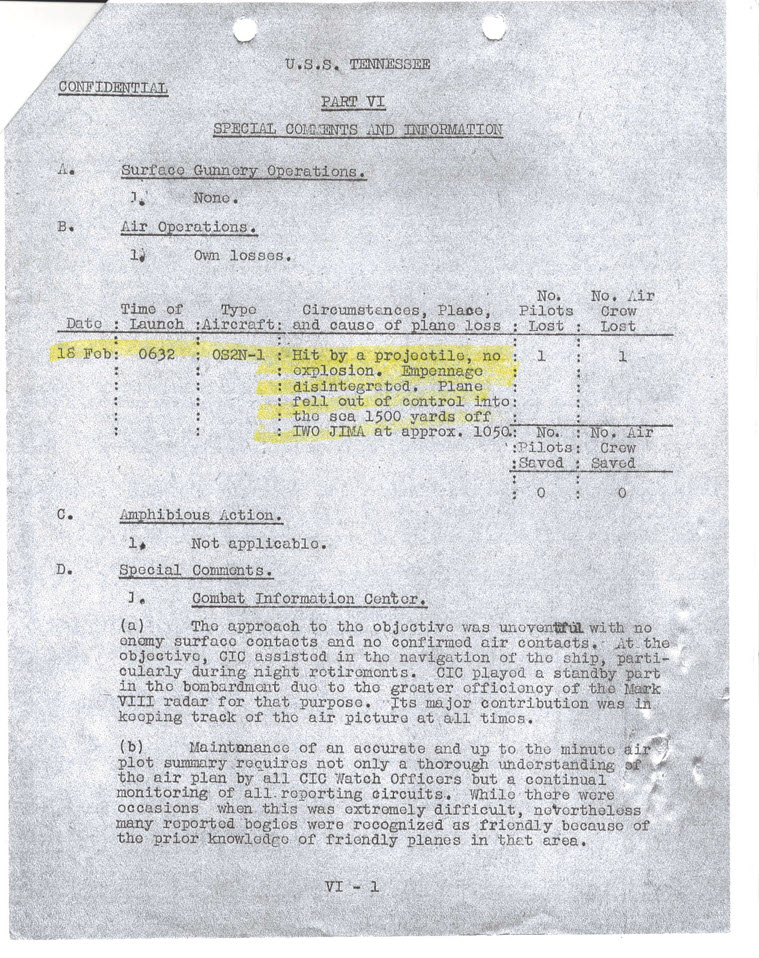
The first hint of the strange circumstances of Tommy's death was found by Frank McCormick in the log of the Battleship Tennessee.
That explained why there was no explosion when Tommy was hit. A large caliber shell would easily go through a small plane without exploding. And if the Navy suspected that happened, you can be pretty sure Tommy was killed by friendly fire. That also helped explain why the family never knew what happened. The report was confidential, and even after the war the Navy would not want to tell his grieving mother that her boy was killed by friendly fire.
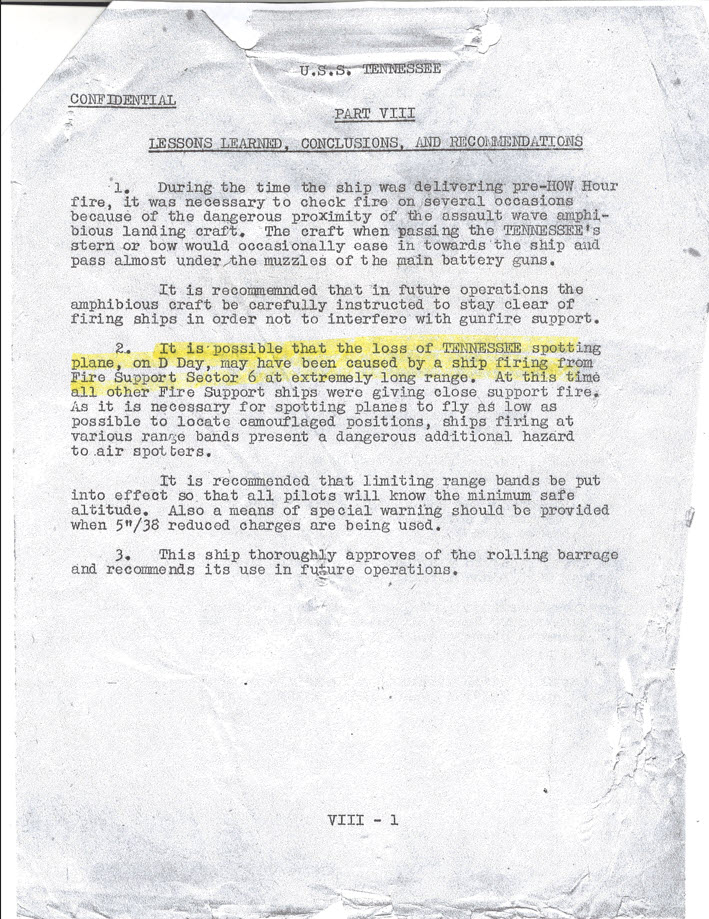
This "after battle" report, supplied by Paul Dawson, was confidential and probably not seen since 1945. It suggests death by friendly fire.
But somebody obviously made a big mistake on that day. It was already standard procedure for pilots, even at relatively low altitudes, to keep well above the gunfire they were observing. And, by Iwo Jima, Tommy was experienced in obeying that rule, as were the gunners on the big ships.
So, as the fog of war lifts, a new mist appears. We can’t find an exact timeline, but Tommy was in the air an hour before the first marines hit the beach at 9 a.m. The Japanese deliberately let the landing site become crowded with men and equipment, who had a hard time moving across the surprisingly soft volcanic ash. Then, they put their clever plan into action. The initial opposition the Marines encountered had been at ground level, until they were surprised by devastating fire from hidden positions in caves on Mount Suribachi which overlooked the beach. Many of their casualties occurred in those first hours. Several days later the Marines captured it, memorialized in the famous flag raising photo.
It would seem obvious that the supporting Navy ships would quickly shift from nearly direct fire on ground targets to the new higher ones on Suribachi. Tommy’s plane was hit about 10:50. It went down off Suribachi, suggesting he was in position to observe that target. Could it have been that the big Navy guns were elevated to hit the higher targets before Tommy’s Kingfisher could gain the necessary altitude to stay above their trajectories? What we may have here is a failure of communication. We probably will never know.
After 78 years, the fog of war can be persistent.
Sunday’s Sun-Sentinel column by Steve Bousquet – huge insider contracts in a previously obscure entity known as the North Springs Improvement District, which operates in Coral Springs and Parkland. Contracts worth $16 million have gone to companies owned by the man who apparently controls the purse strings of this quasi-government entity that has little oversight.
Bousquet credits the story to Bob Norman, a long-time investigative reporter who has broken or collaborated on some of the biggest scandals of the last 30 years. Not surprisingly, a spokesman for the embattled district used the Trump/DeSantis style defense – attacking the messenger.
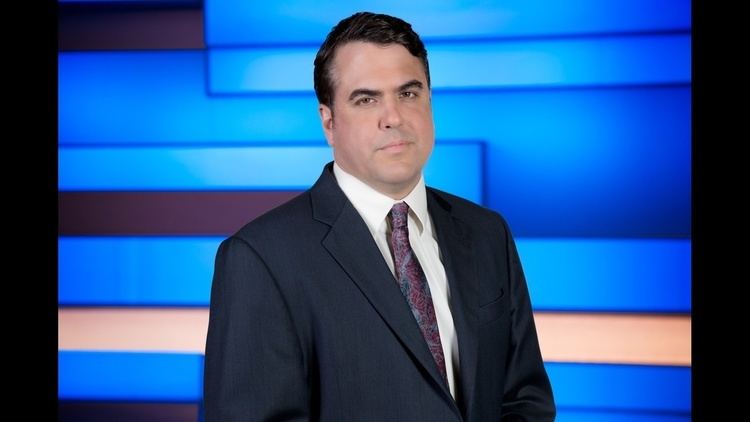
Bob Norman joined TV Local 10 in May 2011 after 13 years as a print journalist in South Florida.
In Bousquet’s words, the spokesman attacked a “blogger who does not work for a reputable news company.” This suggests Norman is some sort of gadfly who can’t be trusted. Woah. This is a writer who, beginning in the 1990s when he was the star reporter for Broward New Times, was deeply involved in the Scott Rothstein Ponzi scheme financial fraud case, caused a major shakeup in the North Broward Hospital District which had been beset with political manipulations and led a number of other high profile investigations which won him numerous journalism awards. Hardly a nobody.
Norman today is editor of the Florida Center for Government Accountability, a watchdog organization. If one wonders how he wound up with the current investigation, the reason traces to the decline of major newspapers. Constant staff cutting has left them without the resources to act on tips that lead to investigations. The Sun-Sentinel and Miami Herald both do an admirable job of reporting on the attempted dictatorship of Governor DeSantis and other major events, but their small staffs are too busy covering daily murders and immigrant drownings to adequately cover all the lesser-known entities such as the North Springs Improvement District, which are ripe for insider exploitation.
Norman’s work is part of a national trend. Top reporters for major papers, who have been forced into early retirement or been laid off, have formed independent groups filling the void left when papers came under financial pressure. These organizations operate on a shoestring, often use highly motivated volunteers, and rely on contributions from those interested in good government. These watchdog organizations rarely have large online followings, but they reach influential figures, as well as mainstream media. The Sun-Sentinel’s Bousquet picking up Bob Norman’s work is an example.
Other organizations doing similar work locally are Florida Bulldog, headed by Dan Christensen, which has broken stories of national importance such as high-placed Saudi Arabians involved in the 9-11 attacks, and Broward Beat, Buddy Nevins’ blog, which concentrates on local politics.
Media, especially print, is in sad shape these days. Whole networks are devoted to distortion of the daily news or direct misinformation. Nonsense abounds, to the point that some people think God is calling them to overthrow their demonic government. In such troubled times, blessed are the messengers.
A phenomenon of our time is that things we once took for granted, such as history, are now being challenged. Florida leads the way in making sure our schools, at least the public ones, are not poisoning young people’s minds with woke nonsense, such as that slavery once existed in our country and the residual effects have taken a long time to overcome.
In investigating this controversial subject, we have discovered that among the many myths long promulgated in our history books was that there once was a Civil War. Admittedly there was a problem, back in the 1860s, when what started as a peaceful protest in South Carolina got a little out of hand. But like the more recent Jan. 6th Washington event, it was really just patriots exercising free speech. And when General Sherman, if he ever really existed, marched across Georgia, it was just typical tourists from Minnesota wanting to see how their southern neighbors got on.
Over the years, various commercial interests have taken advantage of the Civil War myth to make money. Battles that many people still believe actually happened are products of local chambers of commerce, aided by willing Hollywood filmmakers and other media. As columnist George Will has noted, visitors to Gettysburg have been heard saying there could not have been much of a battle there because there are no bullet holes on the monuments. In fact, many of these so-called battles appear to be concocted just to attract visitors to our national parks.
We can trace the Civil War myth back to the 1920s when Margaret Mitchell wrote a book called “Gone With The Wind” which later became a wildly popular movie. With characters such as Scarlett O’Hara, Rhett Butler, and Mammy, none of whom ever existed, it made war seem so romantic that writers have been enlarging the theme ever since. You might call it systemic fairy tales, whatever that means.
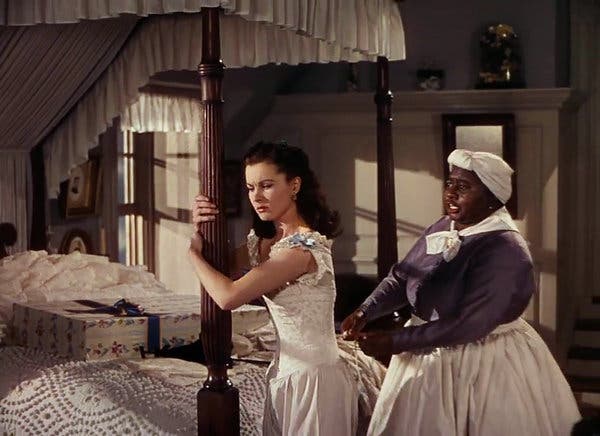
The 1939 film adaptation of Margaret Mitchell’s ‘Gone with the Wind’ starring Vivien Leigh and Hattie McDaniel as Scarlett O’Hara and Mammy.
Once these historical myths get rolling, they are hard to contain. Getting the Civil War out of our history books altogether may be a hopeless task. There is too much money being made by producers of Confederate flags and politicians keeping their names alive by arguing about woke stuff. But as long as Republicans control Florida, we can expect them to give it the old college try. Although, they aren’t likely to permit the topic to be discussed in college.
If one follows the Miami Heat in the newspapers these days, it is sometimes hard to find out if they won or lost. But what is not hard to find is an injury report, which seems to appear on a daily basis. In just the last few days, headlines read "Butler: I will get this thing right," which was about Jimmy Butler trying to get healthy after missing half of the last 24 games, and "Martin plays through pain,” detailing Caleb Martin playing with an ankle sprain. When half the players who starred last year are not playing — replaced by players brought up from the minor leagues — can a fan be faulted for losing interest in the entire program? And it just isn't the Heat missing stars like Jimmy Butler and Tyler Herro. Many teams in the NBA are in the same fix.

This 2020 photo of Jimmy Butler captures a too familiar moment. (Kevin C. Cox/ Getty)
For perspective, think back a few generations to imagine Boston Red Sox fans watching a game without Ted Williams, or the Yankees without Joltin' Joe Dimaggio, or the Celtics minus Bill Russell or Larry Bird. Not much bang for a buck. But for basketball fans, that is the reality. James Naismith would hardly recognize the game he invented in 1891 that was not as rough as football and could be played indoors in winter months. But Naismith's concept has, over the years, been perverted to the point that NBA teams often have more key players out with injuries than NFL football teams. The reason is obvious: whereas football constantly makes rules to protect players, such as face masks and targeting penalties and illegal blocks, basketball has done the opposite. Rules against discontinuing, palming the ball, traveling and charging have been so relaxed over the last few decades that physical contact occurs on every other play. Players routinely collide when driving to the basket at high speed, and the foul, if called, is usually on the defender. The physical aggressiveness of Jimmy Butler makes one wonder why he isn't hurt on every play, much less every game.
It wasn't always that way. Back in 1968, we followed the Philadelphia 76ers for Philadelphia Magazine for the first 18 games of the season. The Sixers, led by native son Wilt Chamberlain, had set a league record (68-13) the previous season in winning the NBA championship. Chamberlain's supporting cast included rookie Billy Cunningham, Wali Jones, Hal Greer, Luke Jackson, and Chet Walker. Coach Alex Hannum had said he thought his team was good enough to go undefeated — thus, the theme behind the story. In fact, the 76ers were 13-5 to open the season, but that's not the point. As we recall in those 18 games, there was only one minor injury. Four starters played all 82 games that season. That continued a trend from the previous year when Chamberlain did not miss a single game. The reason: despite his great size, Chamberlain did not play a strong contact game. He did not use brute force to overwhelm defenders. Rather, his signature move was a fade away finger roll which rarely got blocked. But he, and the rest of his team, did not have to contend with opponents making contact with the force you see today.
So how do we return to that relatively safe era? It is not realistic to try to go back to the time when rules permitted only one step when a player picked up his dribble and was not allowed to take so few dribbles that it almost amounts to passing to himself. Nor was there such a thing as restricted areas. But a lot could be accomplished if refs began calling fouls on the player who initiates contact. That is usually obvious, especially when both players are moving, and that's nearly every play. If players had to go around defenders, rather than through or over them, one would expect far fewer injuries from awkward encounters.
And Heat fans could be rewarded by seeing Jimmy Butler play most of the time. And James Naismith might cheer from his courtside seat in the graveyard.
The latest Brightline traffic death brings up a topic we have discussed before, but since nobody listened, we repeat our view. The FEC tracks are inherently incompatible with high speed trains. No matter how many barriers you erect preventing vehicles from entering the tracks when trains are coming, there are always drivers who will manage to get around them. According to the Sun-Sentinel, the driver killed in Boynton Beach over the weekend actually went around cars stopped at crossing gates. Reckless and illegal in the extreme, but that is just going to happen until the FEC is rebuilt to eliminate potential collisions. There is nothing novel about rebuilding railroads. Busy northeastern railroads, such as the Boston to Washington corridor which hosts the Acela train, eliminated grade crossings years ago.
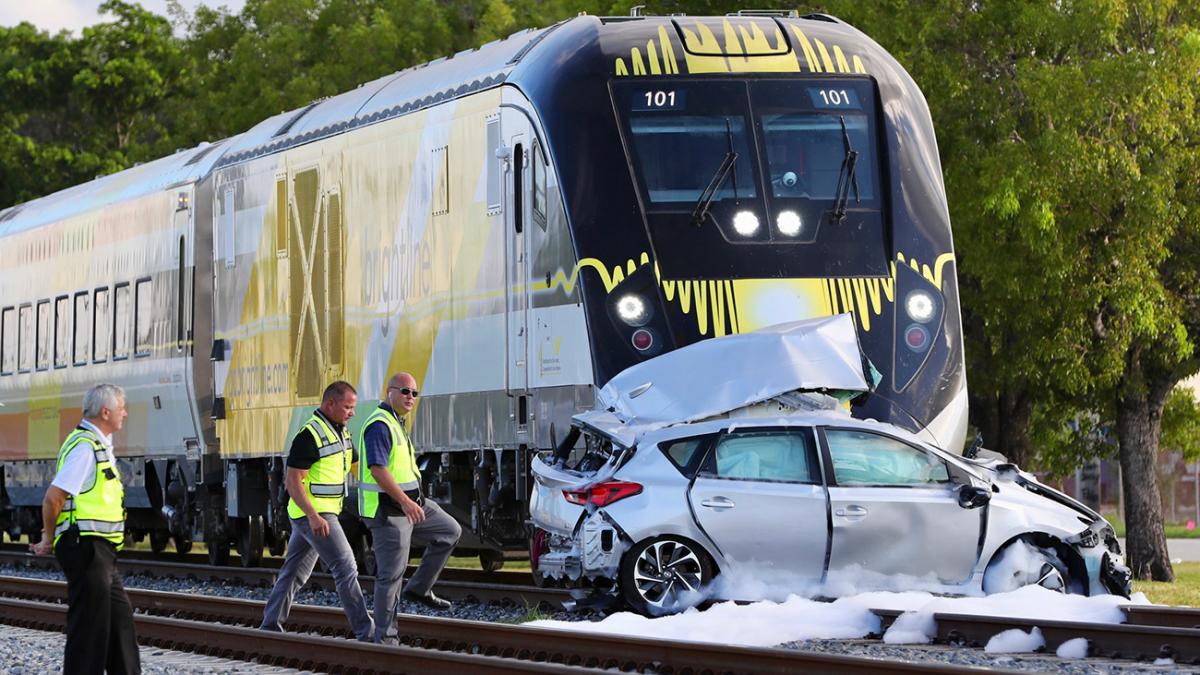
A Brightline train hit a disabled car in Hallandale Beach in September, 2022. (Amy Beth Bennett, Sun Sentinel)
We have surveyed the FEC tracks from Dade County to Palm Beach, and actually rode in the freight train driver's cab on two occasions. There are a number of places where crossings can either be closed, without too much inconvenience to motorists, or bridged without much damage to existing structures at the crossings. Notable among them are stretches of largely unobstructed track in the vicinity of airports - both the big one at Fort Lauderdale-Hollywood International and Executive Airport in north Broward. Such closings, coupled with fencing to prevent pedestrians from accessing the tracks, would permit trains to safely go even faster than the current 79 miles per hour for nice stretches. That should permit Brightline to slow a bit, say to 50 miles per hour, in more congested areas without seriously affecting the current timetables.
This becomes more important as new stations, in Boca Raton and Aventura, come on line. These will make Brightline more useful to many riders, but will also slow the timetables. Brightline is an inter-city concept, and you don't want it to become a frequent stop commuter line. If the cost of modernization seems daunting, compare it to the sums involved in building interstate highway systems with all the exit ramps and soaring overpasses. The rail improvements could be done gradually. After all, to coin a phrase, Rome wasn't built in a day. And neither was the FEC.
The sight of a B-17 spiraling down in smoke or plunging in pieces was not terribly shocking over Western Europe in 1943 or 1944. America’s famous Flying Fortress, although prized by its crews for its ability to bring them home despite serious battle damage, was not invincible. Of the nearly 13,000 Boeing bombers built, more than 4,700 went down in combat, most of them in the skies over Germany and France. But none of those casualties created anything like the shock in Dallas last week when thousands of people at an air show saw a B-17 disintegrate at low altitude when it collided with a smaller fighter plane. All five people aboard the planes died.
The tragedy is under investigation, but from the video already published, it appears the fighter plane hit the B-17 in the middle of its fuselage, and the force of its spinning prop broke the bomber in half. It is ironic that the fighter was the Bell P-63 Kingcobra, a variation of the P-39. That plane was ill-fated from its debut in the early days of World War Two.
It was one of the few modern fighters available when the United States entered the war. An innovative design, the engine was behind the pilot and connected to the prop with a long crankshaft. It was troublesome from go. Pilots worried about that crankshaft running underneath their seats. Although it had a sleek design, it never lived up to its high speed billing and did not fare well against Japanese fighters in the early days of the South Pacific conflict. It was replaced as soon as better fighters arrived. The British rejected it because it lacked high altitude capability, which made it useless against the German fighters of that era. Most of an improved version, the Kingcobra, went to Russia, which would take anything that flew. They used it in a low level ground attack role.
B-17s have performed in many air shows and demonstrations over the years. Most are routine, but there have been other accidents. One came close to home. In 2003, the Collings Foundation brought its Fortress to Stuart and invited the press to take a ride. We accepted eagerly. The flight was brief, only about 15 minutes from Stuart to Vero Beach. There were small benches on both sides of the plane, but you were allowed to roam about. We spent some time near the tail wheel which was being cranked by hand (a surprise) and met the man doing the job. He was Ernest (Mac) McCauley, who we later learned was one of the most experienced B-17 pilots.
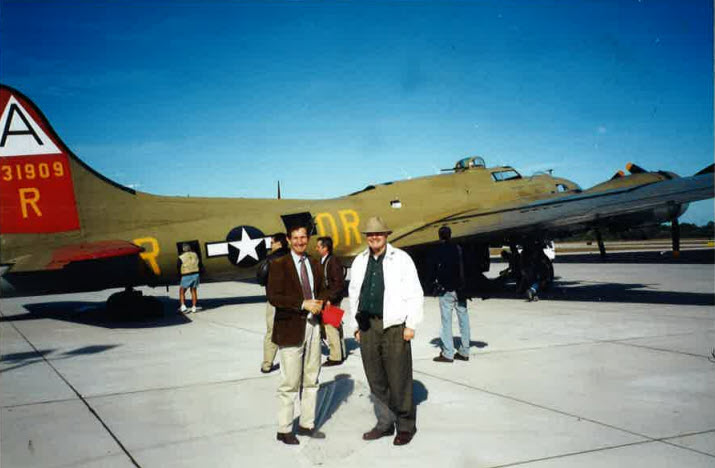
The author, right, following a B-17 flight in Vero Beach.
The pilot that day was a young woman, who apparently was not totally trusted by McCauley. As we prepared for takeoff we heard him mutter, “That girl is going to ruin this plane.” Whatever disturbed him was not obvious to this passenger. Anyway, the flight went smoothly, and we came home feeling fortunate to have flown in a classic. Fast forward to October, 2019. A B-17 with 13 people aboard made a crash landing at Bradley International Airport in Hartford, Conn. It seemed the plane had engine trouble on takeoff and could not gain altitude. The pilot shut down an engine and turned the plane back to the airport. But it turned out its approach speed was too slow and it hit ground short of the runway, skidded into a building and burst into flames. The pilot and six others died.
The tail of the plane survived the flames, and from that, we were able to tell from the serial number that it was the same plane we had flown years before. An investigation determined the crash was caused by inadequate maintenance and pilot error. The pilot, who was also in charge of maintenance, did not survive to defend himself. He was Mac McCauley, the same man who criticized the young woman who took us up from Stuart and brought us down in one piece in Vero Beach.
We have been reading lately about the contrast between America's high minded founders and men who dealt with subsequent crises, comparing them to current elected officials who seem concerned only about their own status and power, country be damned. For instance, how would Abraham Lincoln, who risked his career and ultimately gave his life to preserve a divided nation, react to the current challenges such as the whole world wanting to move here?
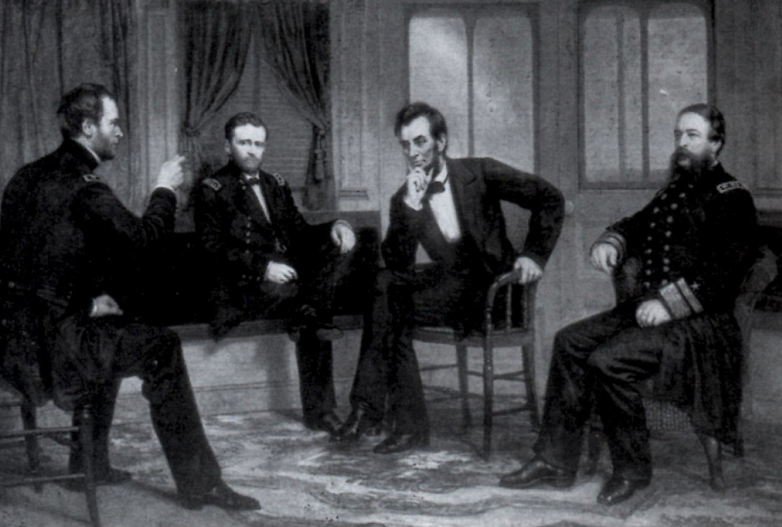
Lincoln with generals discussing immigration.
As often happens when we contemplate such thorny issues, the answer comes to us in a dream. The insights of dreams are intriguing because they are not constrained by time. Things we enjoy today do not exist, and vice versa. People long dead are back to life, and people in dreams who are close friends, turn out upon awakening to be utter inventions. Thus it was that we were enjoying a noon cocktail in Washington's Willard Hotel one day in the spring of 1865, when who should drop in but Abraham Lincoln himself. We were old friends, and he was his usual charming self.
"Except me, Mr. President," said the voluptuous female bartender, "but would you mind taking off that big hat? It's blocking the TV. And General Grant has been trying to reach you. He's telegraphing from Monkeypox, Virginia, or something like that."
"Good man, Grant," said Lincoln. "I cannot spare him. He fights."
We barely got into small talk when the bartender came over again. "It's Grant again, Mr. President. He says it's urgent."
"Please tell him I'll get back to him. I have more important things on my mind than a damned war. That's all Grant wants to talk about. I have other cultural issues pressuring me - like immigration."
The bartender again approached, "Mr. President, General Grant on the telly again. He says General Lee wants to surrender. He needs advice on terms."
Lincoln replied: "Tell him with malice toward none, with charity for all, with firmness in the right as God gives us to know the right - you know, that little speech I gave last month"
Returning to our conversation, Lincoln apologized, "Excuse me. They have no idea how much trouble these immigrants are causing me."
"What immigrants?" we asked.
"The Irish. They are rioting again in New York. And they talk funny, drink around the clock and want their own churches and everything. They’re trying to take over the country. And they keep coming day after day."
"But," we noted, "The Irish Brigade is one of your best outfits. Battle after battle, they save the Union army. Bull Run. Seven Days. Fredericksburg. They got slaughtered. And the Wheat Field at Gettysburg."
"They're too drunk to know better."
The bartender interrupted, "Hate to keep bothering you, Mr. President, but it's Grant again. He says Lee has tickets tomorrow night for the La Salle-Richmond game and really wants to get this surrender signed today. He wants to know if his men can keep their horses. He says most of them own them."
"Sure," said Lincoln, "and they can keep their girlfriends, too. Tell him not to bother me when I'm dealing with cultural issues. This immigration thing is driving me bananas. Now the Germans are pouring in. Nobody in Kansas and Iowa speaks English. How do you stop people who want to ruin our country just because they want freedom? We're going to wind up with a country filled with extremely disciplined alcoholics."
"That's a wonderful thought," said the bartender, "but you must be dreaming."
"I probably am," said Abraham Lincoln. "I'm going home to sleep it off."
"Don't forget your hat," said the bartender. "If anybody sits on it they may get hurt."
Sunday night the Miami Dolphins will celebrate the 50th anniversary of their 1972 team, the only team ever to go undefeated in the National Football League. That team remains unique after all these years, and on this anniversary, it is well to recall that it is distinguished for another quality. In a word - class.
It begins with the owner, Joe Robbie. He is the man who spent the money to acquire the best young coach in football: Don Shula. Shula had built the Baltimore Colts into a power. In contrast, the Dolphins had been one of the worst teams in pro football, but Shula recognized the nucleus for a winner and quickly made it one. He put together a great coaching staff and demanded his players realize their potential. The first year was 10-4, and South Florida began to take notice. So did our Gold Coast magazine, which we took over that year. We were trying to convert a social magazine (the original name was Pictorial Life) which featured people dancing for disease, into a broader appeal regional book. Sports stories were a natural addition.
The Dolphins got off to a fast start in 1971, winning seven of their first nine games. Fans began to get excited about their prospects, and we decided to jump on the bandwagon. It was past mid-season before we began hanging around practice sessions, picking the brains of the beat reporters, and went on the road with the team to Baltimore, where they won a tough game, and then to Boston. It was a cold day in Foxboro, and the Dolphins did not play well, losing 34-13. But the game provided two memorable moments. Power fullback Larry Csonka fumbled for the only time all season, and a Boston freelance photographer, whose name has been lost, took our all-time favorite photo in Gold Coast's 50 year history. It was Shula leading his team onto the field, the determination on their faces suggesting a charge to destiny. That came the following year.
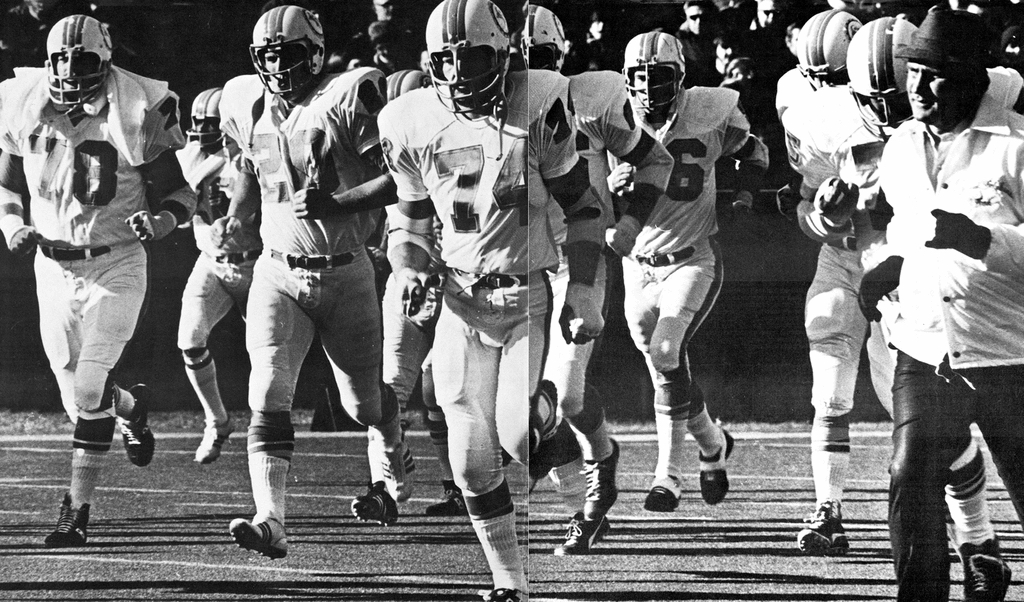
That team won a second Super Bowl the next year, with essentially the same coaches and players. And what an organization they turned out to be. Owner Joe Robbie built a modern stadium with his own money. He had a checkered reputation, and some publicized family problems, not helped by a fondness for alcohol. But over their long association, he let Don Shula have a major hand in running the football business as one of the most successful in sports history. In that respect, he was a class owner.
Shula's reputation needs no embellishments. A control freak and hard driving coach, he was also fair. A Philadelphia sports writer said when it came to all aspects of the job, including tactful handling of the press, Shula was the best. He rarely said anything stupid, at least not for publication. He became one of South Florida's most respected figures. His assistants on the undefeated team reflected his example. The offensive coordinator Howard Schnellenberger went on to lead the University of Miami to a national championship, and later put Florida Atlantic on the football map, first as its founding coach, then as the fundraiser for a campus stadium. And he did it all with grace and class. Defensive coordinator, Bill Arnsbarger, went on to a long career as a coach and later athletic director at the University of Florida when the school's athletic program needed a strong reformer.
A number of players on the ’72 team are still considered among the best all-time at their positions, including Hall of Famers Larry Csonka, quarterback Bob Griese, receiver Paul Warfield, and linemen Jim Langer, Nick Buonoconti, and Larry Little. Many of that team left the area after their playing days, but those who remained were often in the limelight. Among them: Bob Griese as a sports announcer, Buonoconti as a business lawyer and philanthropist, fellow Notre Damer Bob Kuchenberg as an art dealer, and Earl Morrall as an assistant coach at the University of Miami and later mayor of Davie. Others still remembered are Csonka as spokesman for Alaska outdoor life and Mercury Morris for his affectionate support for Jim Kiick during his fight against football related brain trauma.
Keep in mind that this was a time before the huge sports salaries. A football player did not make more than an average crooked lawyer. The men needed to work after football.
Almost all of the team members were successful in later life. A prime example is a player not often in the press. Doug Swift was probably the least known member of the Dolphins “no name defense.” Most of the key players on the team were college stars, but Swift played at Amherst, known more for academics that sports. He reached the pros almost on a lark, when his college coach told him he might be good enough. He first went to Canada, where the coach did not have room for him, but suggested he try Miami, where Don Shula was building a promising team. Swift did, made the team in 1970 and was a starting linebacker for six seasons.
He had another career on his mind. Both his parents were physicians and he was one of the smartest and classiest guys on a team of smart and classy people. He took pre-med courses while playing football – quite a feat. He was the only player we really got to know. We ran a piece about this unique pro in Miami Magazine, which we owned at the time. It was remarkable for its candor. He described the feeling of being on the bottom of the pile and body after body thudding as they fell on top, and wondering what was the meaning of it all. And he spoke of resentment of the long prayers and political speeches before playoff games.
Little was heard from him after football, until the mid-1980s when Dr. Doug Swift got a brief mention in the Philadelphia papers for a former pro footballer being the anesthesiologist in the first heart transplant procedure in that city. It got no notice in South Florida, until we contacted him and he arranged for us to watch him in an open heart surgery at Temple University Hospital. If a story ever wrote itself, that one did. It ran in Tropic, the Miami Herald’s Sunday magazine.
Dr. Swift is expected to be among the men honored Sunday night for an historic first and only feat in football history. When those aging former players take the field at halftime, fans will salute more than just the men who made sports history. They will also be honoring class.
When we moved to Florida in 1971, a number of people told us that we were smart to buy in Fort Lauderdale's old Colee Hammock neighborhood. Our house was reportedly 18 feet above sea level and even though we were only a mile from the beach we were high enough to ride out hurricanes with minimal threat, at least from flooding. The only obvious hazards were the old oak trees which could come down in high winds, but that did not happen often. Those trees had been around for a hundred years and sometimes much more. They had seen a storm or two. It was not our principal motive for purchasing there, but it was a reassuring factor.
We had been looking to the west, where most young families were moving at the time, but we were also advised that much of that land was low lying, and prone to flooding. If it seems strange that we were getting such advice 50 years ago, keep in mind that Fort Lauderdale's downtown had seen flooding in the 1960s and people who had been here for a while were quite aware of the water danger when hurricanes came. Since then, various flood control measures, improved drainage and pumping, have been put in place, and people tend to forget the advice about location that we were fortunate to hear five decades ago.
That advice is still useful. People who care about what's going on in Fort Lauderdale know the neighborhood’s at risk. Some of them are very expensive waterfront properties, notably the south side or Las Olas Boulevard. And, as the Sun Sentinel has recently observed, overbuilding in the downtown has the dual effect of paving over land that could absorb water, at the same time exposing greater numbers of people to the dangers of high wind and water. And it can happen, as we learned in 2004 when the freakish hurricane Wilma came through from the west, complete with tornados that did a pretty good job of damaging both buildings and homes unlucky enough to get hit. That included this writer's home which saw an old oak (42 inches at its base) snap about eight feet up and land on our roof. Fortunately the thick branches cushioned the blow, resulting in only three patchable holes. And we were lucky to be home to bale out the water as fast as it poured in.
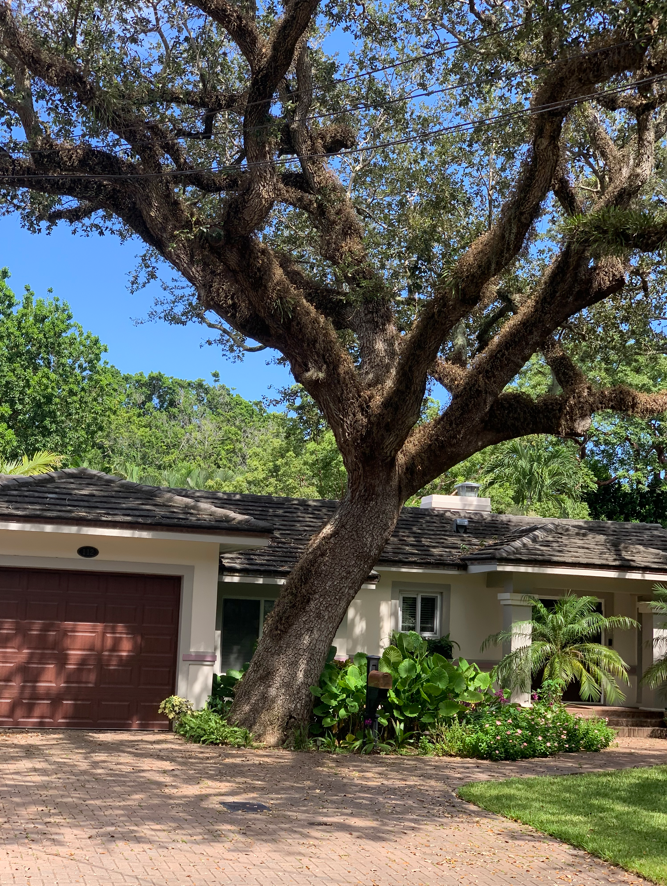
Colee Hammock is known for classic old oaks and high elevation
Our point, of course, relates to the disaster called Ian and the huge number of people who have moved into Gulf Coast communities long recognized as prone to flooding in a major storm. Flood damage is not a rarity. Recent years have seen its effects on Florida's Panhandle, Louisiana and Texas. Florida's southwest coast had been hit hard in the not too distant past, and it was only a matter of time before a really big one would arrive. You have to ask if the builders and real estate people, who certainly knew the score, warned buyers of the dangerous locations - near shallow water posing the risk of storm surge. Judging by the fact that so few had flood insurance suggests the new residents, which are the great majority of people there, were not aware of what they were buying into.
We have seen the pathetic testimony of people who have lost everything and have no insurance or personal resources to recover. At least part of that burden is going to fall on all of Florida and the federal government. We wonder if that is fair to people who bought property more thoughtfully to pay for those who did not? And what about rebuilding? Many of those on Sanibel and Captiva have money, and can afford to rebuild even without government help. But that is not true for people in less expensive towns that were savaged. And should those places even rebuild? And if so, should they not be constructed to withstand the worst case storm such as Ian - those once-in-a-hundred-year events that, if climate change continues at the present pace, may be more like once in a decade? The Jersey Shore has already seen construction of beachfront houses built on stilts to avoid storm surges, but that is a costly remedy that few of Ian's victims can afford.
An irony of all this is that there has been relief that the storm did not hit Tampa Bay as originally projected. The loss would have been much worse. And yet that already highly populated area is expected to grow even faster in the next few years. The worst may be yet to come.
Perhaps what we need are more people who give newcomers the advice we were lucky to get 50 years ago. When it comes to hurricanes, buyers beware.
Florida Bulldog, the independent investigative reporting group founded by Dan Christensen, has often made news over its 13-year history. But that news rarely gets picked up by newspapers, even when it has high local interest. An exception was recently when the Sun Sentinel, in a major story on embattled Broward County Sheriff Greg Tony, gave Florida Bulldog a one-sentence credit for originating the story. Dan Christensen discovered in 2020 that Tony had not revealed during his police career that he had been suspected of murdering a fellow teenager in Philadelphia in 1993. That should have disqualified Tony from ever becoming a police officer, much less sheriff of a large county.
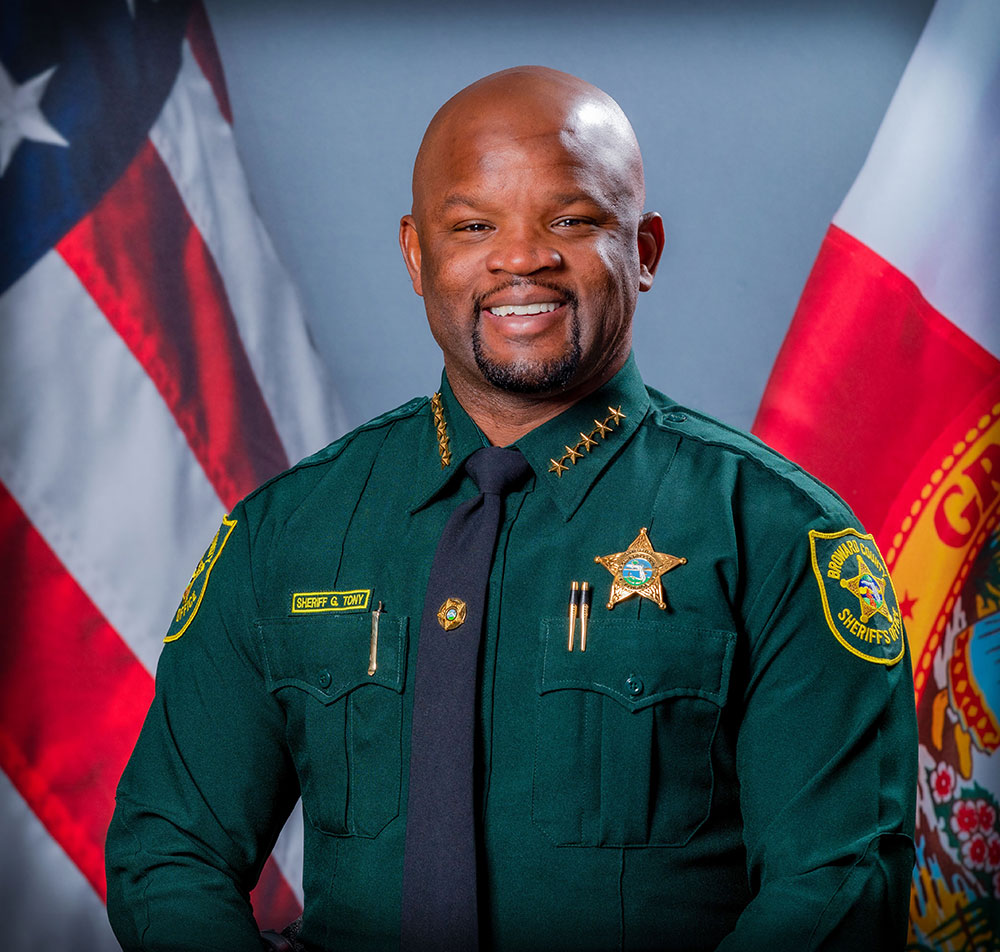
When confronted with the story, Tony said he had been found innocent because he acted in self-defense, fending off an armed attacker. But it turns out the Philadelphia police investigation was shallow, and Florida Bulldog recently learned that several witnesses who were never called in the trial said Tony was not threatened. The victim was unarmed and Tony, after a street argument, took his father's weapon and shot the victim a number of times. Those witnesses thought they had witnessed a murder. That story was picked up in detail by the Sun Sentinel.
A story that to Christensen's knowledge has not been picked up by the Sun Sentinel or any other organization is his latest report on a subject he has pursued for years - the 911 attack. Christensen and Irish reporter Tony Summers got on that dramatic story when they learned that the 911 hijackers were aided by prominent Saudis living in Sarasota during the period when the hijackers trained for the attack. Christensen discovered that such contacts were known to the FBI but withheld from the 911 commission headed by former Governor and U.S. Senator Bob Graham. The government has released information in stages, but only after freedom of information lawsuits and constant prodding by Christensen and others.
Information, obviously known by the government for years, was recently quietly released. It effectively admitted that factions of the Saudi government provided assistance to the hijackers. It is hard to believe that these revelations have not gotten national attention.
Another interesting detail in released documents was reported recently by Christensen. It involves planes that appear to have been headed for disaster, but never got off the ground when flight controllers froze all takeoffs after the first planes struck the World Trade Center. One such plane was Delta flight 23 which was in the takeoff line at JFK Airport in New York. The pilot of that plane, Tom Mannello, was interviewed by Christensen. He recounted that when he heard an airplane had struck one of the Manhattan towers, he assumed it was an accident involving a small plane. Then came a second attack and word from Delta's flight dispatcher in Chicago communicating with Delta's 16 coast to coast flights. When advised of the Trade Center attacks, he warned pilots to protect their doors. Even though still on the ground, Mannello, immediately did that. When he warned flight attendants not to try to enter the cockpit, he was told the chilling information that four young Arabs were seated in first class. The plane taxied back to its gate and passengers got off. There was no word what happened to the four young Arabs.
The dispatcher who issued that warning was Ed Ballinger, who now lives in the Florida Keys. He has been haunted by the fact that information on the attack was slowed reaching him due to a communications problem. Had he issued his warning just minutes earlier, the pilots of Delta Flight 93, which crashed in western Pennsylvania, might have been able to fortify their door and prevent the hijacking. That was the plane where heroic passengers rushed the cockpit when they realized they had been hijacked. In the melee that followed, the plane went out of control.
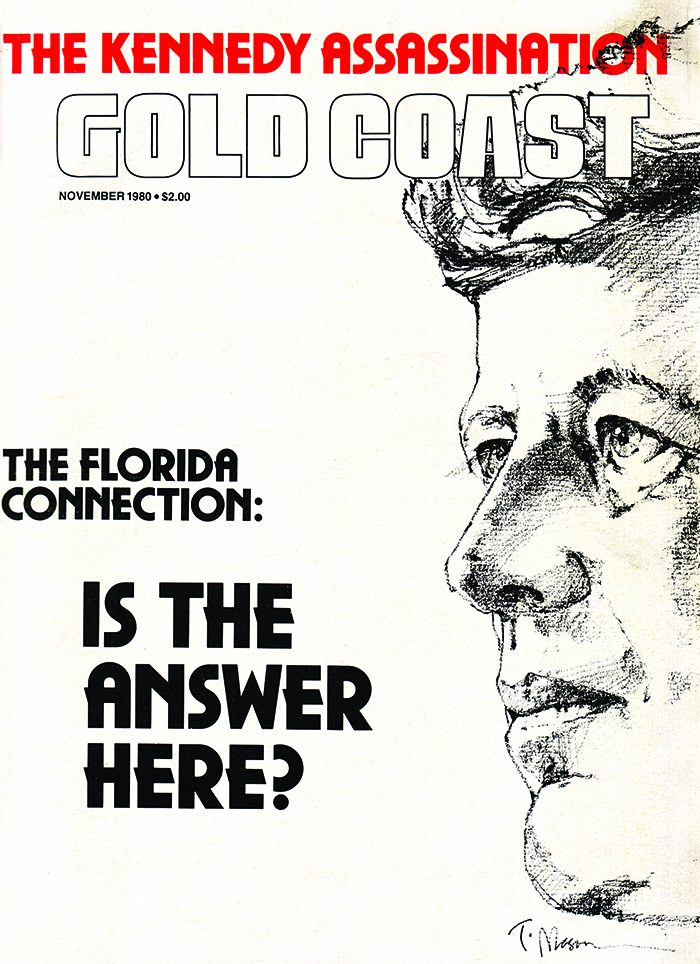
Gaeton Fonzi established a connection between Lee Harvey Oswald and the CIA's anti-Castro leader in a three-part Gold Coast Magazine series.
Government concealment of dramatic information is unfortunately not new. We still don’t know key details of the Kennedy assassination. That is close to this writer’s personal history. Our former partner in Gold Coast Magazine, the late Gaeton Fonzi, began working that story in 1965 when he reported in Philadelphia Magazine that Arlen Specter (later a U.S. senator) could not explain his own “magic bullet” theory, the only way the Warren Commission could conclude that Lee Harvey Oswald acted alone.
Pennsylvania Senator Richard Schweiker recalled Fonzi’s work and hired him when he headed a committee reopening the investigation in the mid-1970s. As the primary investigator working in Florida, Fonzi, through anti-Castro Cubans, made a link between a top CIA man and Oswald shortly before the assassination. It confirmed Senator Schweiker’s view that Oswald had “the fingerprints of intelligence all over him.”
It is a long story, but that investigation was sabotaged by CIA friendly congressmen, when it began to question the CIA. Fonzi wrote most of its final report which concluded that there was a conspiracy (meaning Oswald was not alone) but left the conspirators unnamed. Disgusted, Fonzi wrote a book, “The Last Investigation,” which made a compelling case that the CIA was behind the murder of an American president, and that the original Warren Commission was a sham, controlled by the CIA and an accommodating FBI. The story first ran in Gold Coast and The Washingtonian magazines. It got almost no attention from the major media. And yet, when Fonzi died 25 years later, the New York Times called his book one of the best written about the assassination.
But still, JFK’s death remains largely mysterious. The government, as with 911, admits it knows more, but refuses to tell us.
Almost 70 years after the assassination, people, especially the young, ask why would anybody want to kill such a popular American president? Answer: He was not popular everywhere. The CIA, controlled by Allen Dulles, who had been fired by Kennedy after the Bay of Pigs fiasco, hated him. J. Edgar Hoover, who headed what at the time was a very political FBI, had a widely known distaste for the Kennedys.
At the time both the CIA and FBI were out of control, unaccountable in many respects. President Harry Truman, whose administration saw the CIA’s birth, later realized it was exceeding its purpose as an intelligence gathering organization. The CIA had become a shadow government, involved in coups and assassinations of foreign leaders, and often controlling U.S. policy. President Eisenhower also had seemed concerned about the CIA’s unchecked power. But Kennedy was the first to do anything about it. He spoke of dismantling the spy agency. Then he fired Allen Dulles, but Dulles still secretly ran the spy agency.
That was after the close call in Cuba, when the U.S. found Russia building missile sites there. JFK tried to end the cold war. He also wanted to limit U.S. involvement in Vietnam, which he foresaw as the disaster it turned out to be. These were the opposite of the CIA’s goals, and it considered Kennedy not only a threat to its very existence, but also a dangerous traitor. Hoover at the FBI felt much the same.
Both the CIA and FBI were so arrogant with power that their leaders thought they could murder an American president and get away with it.
And they did.
